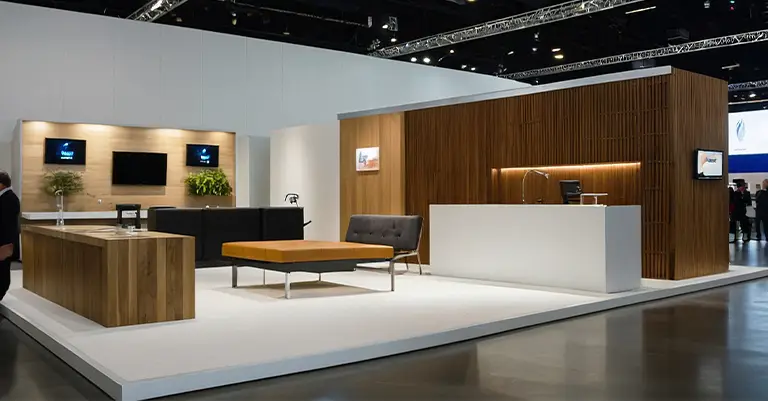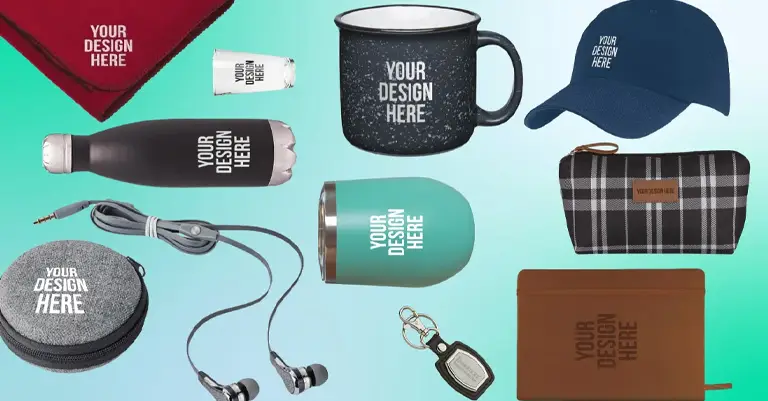Participating in a trade show can be a big step for any business wanting to grow and get noticed. A good trade show marketing plan is crucial because it helps you organize everything from setting goals, budgeting wisely, designing an eye-catching booth, and preparing your team to talk to potential customers. Without a strong trade show marketing plan, you might waste money, miss out on connecting with people, and not get your message across clearly.
Trade shows are great opportunities for businesses to showcase their products, meet new customers, and learn more about their industry. They help companies get more attention, make new contacts, and increase sales. However, a rock-solid trade show marketing plan is necessary to benefit from these opportunities.
Define Your Trade Show Goals
When designing your trade show marketing plan, the first step is to decide what you want to achieve. This means setting clear goals like making more people aware of your brand, introducing new products, getting contact details from potential customers, or connecting with other businesses in your industry. Having specific goals helps you focus your efforts and determine whether the trade show marketing plan was successful afterward.

Examples of Common Objectives
Here are some typical goals businesses have when they go to trade shows:
- Increase Brand Awareness: Help more people learn about your brand and what you offer.
- Generate Sales Leads: Gather information from people wanting to buy your products.
- Network with Peers: Meet new people who work in your industry, which can lead to new collaboration opportunities.
- Launch New Products: Showcase new products to see what customers think.
- Educate Potential Clients: Provide more information about your products so that people can decide whether to buy them.
Aligning Objectives with Business Strategy
Your goals for the trade show must match up with your overall business goals. For example, if your business wants to sell products in new markets, your trade show activities might include talking to buyers from different countries or showing products that appeal to new groups of people. Ensuring your trade show goals support your broader business aims helps make the most of your investment and strengthens your brand.
Research Your Target Attendees
Knowing who you’re trying to reach is essential to do well at a trade show. This means finding out about the people who might come to the show, like what jobs they have and what they’re interested in. This helps you adjust your messages and set up your booth to catch the interest of these people.

Analyzing Past Attendee Data
Looking at information from previous trade shows can tell you a lot. You can see who came before, what they liked, and what they thought of the event. This helps you understand what these people enjoy and what keeps them interested, which can guide you in planning your booth and activities to attract them more effectively.
Tailoring Your Approach to Audience Needs
Once you know what your attendees like and need, you can make changes to better meet those needs. For example, if your attendees are into technology, you might want to include the latest tech in your booth. If they care a lot about the environment, showing how your products are eco-friendly can make your booth stand out. This way, you can ensure your booth is exciting and relevant to the people visiting it.
Essential Budget Items
When crafting your trade show marketing plan, it’s essential to keep track of your spending to ensure you have enough for everything you need. Key things to budget for include renting space for your booth, setting it up, determining travel and hotel costs for your team, determining promotional items to hand out, and shipping everything to the venue. Furthermore, setting aside extra money if something unexpected comes up is also a good idea.
Cost-Saving Tips for Trade Shows
To save money at trade shows, consider these tips:
- Book Early: Get your booth space and hotels booked ahead of time to get cheaper rates.
- Rent When Possible: If you don’t go to trade shows often, rent your booth materials and equipment rather than buying them.
- Use Digital Materials: Instead of spending a fortune on printed materials, use digital versions that people can view on their phones or tablets.
- Only Bring Core Staff: Only take team members who need to be there, which can save on travel and hotel costs.
Investment vs. Return Analysis
After the trade show, check if the money you spent was worth it. This means looking at whether you met your goals, like how many new contacts you made or how many products you sold, and comparing these wins to the amount you spent on the show. This will help you figure out if the trade show was a good investment and will also help you make any changes to your trade show marketing plan the next time around.
Principles of Effective Booth Design
Creating an excellent booth for a trade show is vital if you want to grab people’s attention. Your booth should look good and be easy to walk around in. Make sure to use bright colors and graphics that match your brand and set up your space so people can move through it quickly and avoid congestion.

Incorporating Your Brand into Booth Design
Your booth should showcase your brand. Use your logo, your brand’s colors, and any designs that people recognize from your company. This helps people remember your brand better. Also, ensure your booth fits the advertisements or messages you’ve been promoting so everything feels connected.
Interactive Elements to Engage Visitors
To make your booth stand out, add fun interactive parts like touch screens, live demos, or virtual reality setups where people can try things out. These kinds of activities can make your booth a lot more exciting and help people understand and remember your products better. More engagement often means more people might consider buying what you’re selling.
Preparing Your Team for Success
Your team must know how to succeed at a trade show. This means ensuring everyone understands their jobs, from greeting people and showing off products to gathering contact info from interested visitors. Giving everyone specific tasks will help keep things organized and ensure everything at the booth goes smoothly.
Roles and Responsibilities
Before the trade show starts, decide who will do what. Some team members might welcome visitors, others might show how products work, and some might talk in detail about what you’re selling. Knowing who is doing each job helps avoid mix-ups and ensures visitors get the help they need without any delays.
Effective Communication Training
It’s also super important that your team knows how to talk to people who come to your booth. They should know your products well and be able to listen to what visitors say, answer their questions clearly, and adjust how they talk based on who they’re speaking to. Good communication can significantly affect how people see your brand and consider buying from you.
Engaging Attendees Effectively
Making your booth exciting and fun is essential to get people to visit and stay longer during a trade show. You want to create a welcoming space that grabs their attention and makes them want to learn more about your offering.

Technology Use at Your Booth
Using cool tech at your booth can help grab attention. Think about setting up touch screens where people can swipe through information about your products, tablets for quick sign-ups, or even virtual reality (VR) to give them a fun, immersive experience. These tech tools make engaging visitors and enjoying learning about your products more accessible.
Contests and Giveaways
Holding contests or giving away prizes is another great way to attract people to your booth. You could have a quiz about your products, or a fun game related to what you sell. Offering prizes like free samples or discounts can also encourage people to participate and remember your brand. These activities make visiting your booth a more exciting and memorable experience.
Efficient Methods to Gather Leads
Collecting leads at a trade show means getting contact details from people who might be interested in your products, which helps you follow up with them later. It’s important to use quick methods and effectively capture people’s information.

Digital vs. Traditional Methods
You can gather leads in two main ways: digital and traditional. Digital methods include using devices like tablets or smartphones where people can directly enter their details, scanning QR codes, or using unique apps for trade shows. These methods are quick and ensure you don’t lose any information. Traditional methods involve using paper forms that people fill out, which you must manually enter into a computer later. These are simpler but can be slower and risk losing some details.
Managing and Organizing Leads
After collecting leads, it’s crucial to organize them well. This means sorting them by how interested they are, how likely they are to buy, and what they need as soon as possible. Using a CRM (Customer Relationship Management) system can help keep track of all your leads and make sure you follow up with them correctly. Prioritizing the most promising leads lets your sales team focus on turning those potential customers into actual customers first.
Strategies for Effective Follow-Up
After a trade show, it’s imperative to contact the people you meet who might want to buy from you. Good follow-up strategies ensure you keep their interest and help move them toward purchasing.

Timing Your Follow-Ups
Your follow-up is key, so try to contact prospects within 24 to 48 hours after the trade show ends. This helps keep your business fresh in their minds. If you reach out quickly, it shows you’re serious and keeps the excitement going. For people who are interested but not ready to buy immediately, keep in touch regularly but not too often—you don’t want to annoy them.
Personalization Strategies
Making your follow-up messages personal can make a big difference. Use what you know about each person from the trade show to make your messages feel more special. For instance, you can mention something they talked about at your booth, something about their business, or offer something they might need. This shows you care about their specific needs and aren’t just sending the same message to everyone, which can make them more likely to buy from you.
Importance of Feedback
Feedback is important because it tells you what people think about your trade show booth and products. It helps you understand what you’re doing right and what needs to be improved. By getting feedback, you can make smarter choices to improve your booth and make your presentations more appealing in future shows.
Collecting and Using Attendee Feedback
You can gather feedback in different ways, like talking directly to people at the show, having them fill out forms at your booth, or sending them a survey by email after the event. Make sure it’s easy for people to give their opinions. Once you have this feedback, look at what most people are saying. Use this info to fix problems with your products or booth or improve how your team talks to visitors.
Continuous Improvement Strategies
Continuous improvement means always looking for ways to improve at each trade show. This could involve making your booth more inviting, training your team better, or tweaking what you offer to match what people want. The idea is to keep improving with each event, helping your brand stay exciting and competitive.
Understanding Compliance
It’s essential to follow the rules at a trade show, not just about showing your products but also about handling certain situations. Compliance means adhering to the laws and ethical standards regarding gathering people’s information and promoting your products.

Data Protection Laws
You must be careful when collecting personal details like names, emails, or phone numbers at a trade show. Laws like the GDPR in Europe tell you how to handle this information safely and ensure people know what you’ll do with their data. It’s essential to keep this information secure and only use it in ways people have agreed to.
Ethical Promotional Practices
In conclusion, developing a successful trade show marketing plan is crucial for maximizing your impact and achieving your business goals. With clear objectives, a tailored approach, and a focus on engaging booth designs, you can ensure your trade show is a resounding success. Moreover, to further enhance your plan with a unique hospitality element that will make your booth stand out, consider contacting the Buzz Impressions team. They can help add that special touch to your marketing strategy, drawing more visitors and creating memorable experiences. Reach out today to give your trade show presence a significant boost!




